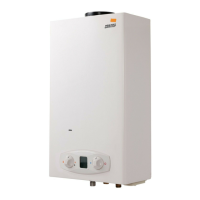fig. 12 - fig.
16 -
3.2 COMMISSIONING
Commissioning of the
heater must be
performed by a trained,
specialized technician.
Checks that must be
performed during the
first ignition, after
maintenance operations
that require unplugging
the unit, and after any
operations on the unit's
safety devices or
components.
3.2.1 Before igniting the heater
• Carefully verify the tightness of the gas
installation using a soap and water solution
to check for leaks in the connections.
• Fill the hydraulic system and make sure no
air is present in the unit or system.
• Check that there are no water leaks in the
system or unit.
• Make sure the grounding and connection to
the electrical network are adequate.
• Check that the gas pressure is correct.
• Make sure there are no
flammable liquids or
materials near the heater.
• To avoid damaging the connections, do not
place the heater on the floor with
the connections facing down.
If the above instructions
are not observed there
may be risk of
suffocation or poisoning
due to gas or fumes
escaping; danger of fire
or explosion. Also, there
may be risk of flooding the
room.
3.2.2 Checks during operation
• Light the unit.
• Make sure the fuel and water
systems are tight.
• Check the efficiency of the
air and flue gas ducts while
the heater is operating.
• Make sure the gas valve
modulates correctly.
• Verify that the heater ignites
easily. Turn it on and
off several times to make sure.
• Check that the fuel consumption
is as indicated.
3.3 MAINTENANCE
3.3.1 Periodic checks
In order for the unit to operate correctly, an
authorized technician must perform an
annual inspection, checking that:
• The control and safety devices (gas valve,
etc.) operate correctly.
• The exhaust vent is perfectly
efficient.
• The air and flue gas ducts and
terminal are free of
obstacles and leaks.
• The burner and exchanger are free of dirt
and deposits. Do not use chemicals or steel
brushes to clean them.

